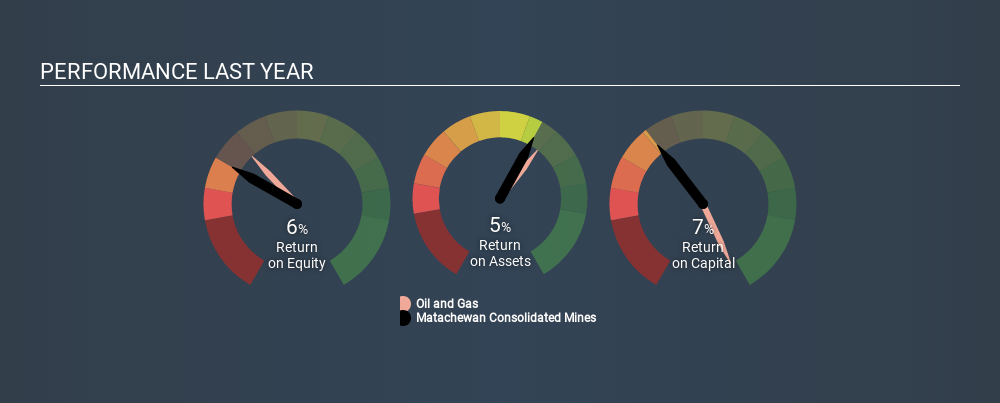- Canada
- /
- Oil and Gas
- /
- TSXV:MCM.A
Should You Like Matachewan Consolidated Mines, Limited’s (CVE:MCM.A) High Return On Capital Employed?

Today we are going to look at Matachewan Consolidated Mines, Limited (CVE:MCM.A) to see whether it might be an attractive investment prospect. In particular, we'll consider its Return On Capital Employed (ROCE), as that can give us insight into how profitably the company is able to employ capital in its business.
Firstly, we'll go over how we calculate ROCE. Then we'll compare its ROCE to similar companies. And finally, we'll look at how its current liabilities are impacting its ROCE.
What is Return On Capital Employed (ROCE)?
ROCE is a metric for evaluating how much pre-tax income (in percentage terms) a company earns on the capital invested in its business. All else being equal, a better business will have a higher ROCE. Overall, it is a valuable metric that has its flaws. Author Edwin Whiting says to be careful when comparing the ROCE of different businesses, since 'No two businesses are exactly alike.
So, How Do We Calculate ROCE?
Analysts use this formula to calculate return on capital employed:
Return on Capital Employed = Earnings Before Interest and Tax (EBIT) ÷ (Total Assets - Current Liabilities)
Or for Matachewan Consolidated Mines:
0.075 = CA$243k ÷ (CA$4.0m - CA$750k) (Based on the trailing twelve months to September 2019.)
Therefore, Matachewan Consolidated Mines has an ROCE of 7.5%.
Check out our latest analysis for Matachewan Consolidated Mines
Does Matachewan Consolidated Mines Have A Good ROCE?
When making comparisons between similar businesses, investors may find ROCE useful. In our analysis, Matachewan Consolidated Mines's ROCE is meaningfully higher than the 5.7% average in the Oil and Gas industry. We consider this a positive sign, because it suggests it uses capital more efficiently than similar companies. Separate from how Matachewan Consolidated Mines stacks up against its industry, its ROCE in absolute terms is mediocre; relative to the returns on government bonds. Readers may find more attractive investment prospects elsewhere.
Matachewan Consolidated Mines's current ROCE of 7.5% is lower than its ROCE in the past, which was 48%, 3 years ago. So investors might consider if it has had issues recently. You can see in the image below how Matachewan Consolidated Mines's ROCE compares to its industry. Click to see more on past growth.

When considering this metric, keep in mind that it is backwards looking, and not necessarily predictive. ROCE can be deceptive for cyclical businesses, as returns can look incredible in boom times, and terribly low in downturns. ROCE is, after all, simply a snap shot of a single year. Remember that most companies like Matachewan Consolidated Mines are cyclical businesses. You can check if Matachewan Consolidated Mines has cyclical profits by looking at this free graph of past earnings, revenue and cash flow.
Matachewan Consolidated Mines's Current Liabilities And Their Impact On Its ROCE
Liabilities, such as supplier bills and bank overdrafts, are referred to as current liabilities if they need to be paid within 12 months. The ROCE equation subtracts current liabilities from capital employed, so a company with a lot of current liabilities appears to have less capital employed, and a higher ROCE than otherwise. To counteract this, we check if a company has high current liabilities, relative to its total assets.
Matachewan Consolidated Mines has current liabilities of CA$750k and total assets of CA$4.0m. As a result, its current liabilities are equal to approximately 19% of its total assets. This very reasonable level of current liabilities would not boost the ROCE by much.
The Bottom Line On Matachewan Consolidated Mines's ROCE
If Matachewan Consolidated Mines continues to earn an uninspiring ROCE, there may be better places to invest. But note: make sure you look for a great company, not just the first idea you come across. So take a peek at this free list of interesting companies with strong recent earnings growth (and a P/E ratio below 20).
If you are like me, then you will not want to miss this free list of growing companies that insiders are buying.
If you spot an error that warrants correction, please contact the editor at editorial-team@simplywallst.com. This article by Simply Wall St is general in nature. It does not constitute a recommendation to buy or sell any stock, and does not take account of your objectives, or your financial situation. Simply Wall St has no position in the stocks mentioned.
We aim to bring you long-term focused research analysis driven by fundamental data. Note that our analysis may not factor in the latest price-sensitive company announcements or qualitative material. Thank you for reading.
About TSXV:MCM.A
Flawless balance sheet with solid track record.
Market Insights
Community Narratives





